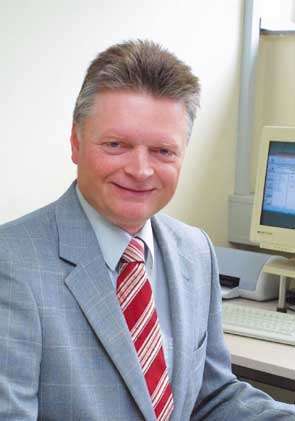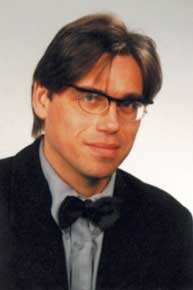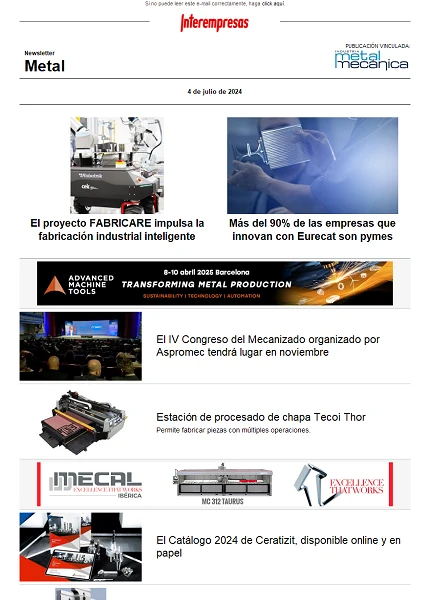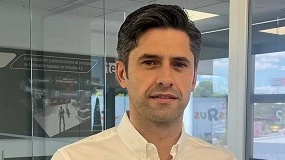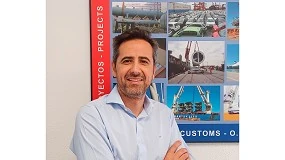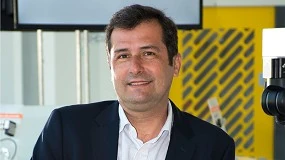Este artículo fue escrito originalmente en Spanish. Se ha traducido automáticamente para su comodidad. Se han hecho esfuerzos razonables para proporcionar una traducción precisa; sin embargo, ninguna traducción automática es perfecta, ni es su intención la de sustituir a un traductor humano. El artículo original en Spanish puede verlo en
La automatización como herramienta para mantener la competitividadThree German projects explore ways to increase productivity
Automation as a tool to maintain competitiveness
Those companies that do not wish to relocate its production in countries with low labour costs must automate certain manual operations and streamline other processes that generate little value. In the symposium entitled "machines advanced tools for the production of tomorrow", which took place at the EMO Hannover 2005 show, were presented three oriented research projects, which are other so many points of entry on how to increase productivity in the German production sites.
Manfred Dresselhaus of Reis Robotics: "In close collaboration with manufacturers of components, we try to obtain a more accurate".
Jörg-Michael Nussbaum of Cross Hüller: "the project HarWeST is intended cut costs in the production of cubic parts series"
Polar, Advocut and HarWeST are the names of the research projects - promoted by the BMBF (Federal Ministry of education and German research) - submitted under the heading of "New machine tools", which falls within the "research for the production of tomorrow". With the title "Automation", these three projects explore different ways to remain competitive in the production of Germany centers. In the Polar project, the participants are working on a system of industrial application for grinding of 3D surfaces using beams of laser; the objective is to automate work so far has been carrying out manually. For its part, the goal of Advocut is to create a machine tool based on a robot capable of carrying out work - until now manuals-deburring and some operations of court with little accuracy requirements, industrial. HarWeST has a slightly different approach: this project focuses on the creation of a complete plant, with the aim of designing intelligent interconnections between the machines tools, handling and other components included in the process; the result would be optimised and, ultimately, an optimized system-wide automation.
Several industrial enterprises and institutes of higher education have been since the autumn of 2003 working in the creation of practical applications within these three projects, with oversight and funding of the Division of production and technologies (PFT) manufacture of PTKA Karlsruhe Research Center.

The potential applications of laser polishing are porous materials which can offer surfaces without defects, promising applications for implants and construction of moulds.
In the interdisciplinary project Advocut, companies, universities and institutes working together by combining a concept of integration of machine tools with the robots.
The polished by laser beam replaces and enhances a tedious manual work
In industrial production, the work of finishing tend to take shape in an activity of manual polishing: on the construction of tools and moulds, in the manufacture of machines in general, in the automotive, in the field of medical engineering industrypharmaceutical, food and biotechnology sectors and household goods industries. This work consume valuable time and resources, but he has been with the assistance of pneumatic and electrical equipment. For example, manual polishing of injection moulds has a duration of 10 to 30 minutes per square centimetres. Grinding machining methods have only managed to set up partially in the sector: the results offered are often unsatisfactory and may not apply at all to many complex three-dimensional geometries.
The polished by laser beam opens up new perspectives for the production of highly polished metal surfaces. This method, completely new, is to melt a thin surface layer of less than 100 µm in thickness for the purpose of polishing. The molten layer alisa for effect of surface tension, without mechanical aid. However, there is no machine tool that can be used industrially for grinding by laser beam, so Polar Research project aims to develop and build one. Rüdiger Gnann, coordinating company Karl H. Arnold Maschinenfabrik, located in Ravensburg, has the very clear idea: "[the polished by laser beam] is a universal method for generating surfaces on the scale of the nanometer". With one finger you can feel the roughness of a surface of two or three micrometers; "However, surfaces polished with laser are totally smooth and are ideal for applications in the medical or food sector, in order to avoid the emergence of bacteria or similar bodies in the area."
Center of conventional machining of five axes equipped with a source of beam of laser and optical instruments
Along with Steffens und Fohn NC-Systemtechnik GbR, Herzogenrath, EdgeWave GmbH and the Fraunhofer Institut für Lasertechnik (ILT), both located in Aachen, Arnold Maschinenfabrik is working in the manufacture of a system of polishing laser for industrial applications. The tool is based on a center of conventional five-axis machining, manufactured by Hermle, that instead of presenting a spindle of milling uses a source of beam of laser and optical machining instruments, located in the spindle box or on the z axis. In contrast to the spindle, these two components can move linearly in directions x, y, z. Work pieces can revolve around two axes.
The polished with laser beam imposes certain requirements on the source, so that the project is underway in the creation of a laser beam source appropriate for the preparation and the finely machined in two stages of the process of polishing. In addition, for operations with automated tools machines, expanding the basic machine control software to direct the laser beam source, optical instruments of machining, process gas supply and the control of the same.
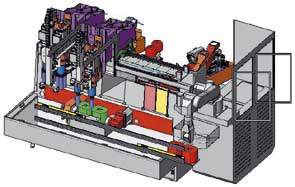
To demonstrate the independence of the manufacturer and the transfer of the vested methods, the participants of the project will implement their developments for two families of different pieces.
With the laser beam can Polish even porous surfaces
The ILT in Aachen, has at the moment the first prototype of this machine, whose results will soon apply to other machines, explains Rüdiger Gnann: "The new machine tool achieves reduce time and costs of production." Not only that: reproducibility and quality are the best. "In view of this, soon you will get buyers to this machine". Moreover, emerging new areas of application that could not use grinding machining; for example, in the grinding of porous materials, such as precision molds and the injection of metal moulds. The polished through boot of shavings machines can lay bare the pores and, therefore, cause surface defects. The molten material that is deposited in the polished with laser beam seal these pores and allows you to create flawless surfaces.
An Assistant of low cost: the robot as a machine tool
There are other production tasks that still continue manually because, simply, there is a right tool machine (that is, adequate from the technical and economic point of view). Thus, operations deburring of complex stamping and the manufacture of synthetic fibre composite moulds, for example, are still carried out manually and require much labor. A machine tool flexible and low-cost, which could be economically these tasks so expensive and that require both staff, would have a great acceptance in the market.
The objective of the interdisciplinary project Advocut is precisely the development of a machine tool of this kind. Some industrial companies and academic institutions are working together to combine the advantages of a robot, a machine tool completely new and highly integrated with regard to the flexibility and cost, with the qualities of precision and machining machines provided by conventional tools. The objective is to design and create a process cinematic, almost robotic, of production chain, equipped with an integrated motor spindle of high frequency and sensors and controllers adapted
Creation of joint for greater precision sensors, actuators and components
According to Manfred Dresselhaus, project coordinator of Reis Robotics, manufacturer of robotic components headquartered in Obernburg, the greatest challenge is in accuracy: "Normally, a robot can give you a repeat accuracy of a few hundredths of a millimeter." A robot does not present, not even close, the rigidity of a milling machine; the forces generated by a milling machine with spindle, for example, affect the precision. "We are trying to ring or minimize these negative effects in a project developed in close collaboration with several manufacturers of components". As a starting point it is working on the servo in the boards, which should provide regulation of high-precision. Also, the work are also focusing on the spindle and the tools used in the process. Forces Court of these elements should be placed at levels lower than possible if their negative effects to minimize.
The participants were convinced of the success of the project: to this end, the process includes transfer of the major powers to the different partners in the project, the development of integrated motor spindle modules and cinematic elements the introduction of sensors and actuators in all cinematic elements both motor spindle, and the iterative development of each of the components for the development of the entire system. Last year was a machine of demonstration which is being refined at the moment in the PTW in Darmstadt Institute. Nevertheless it is unlikely that this demonstration machine can occur at the EMO Hannover 2005 fair. Before the Symposium, however, be carried out a series of measurements and tests, whose results will give a clear idea of what this new machine tool "Robotics quasi" can offer the end user.
HarWeST: acceleration and costly process of zero value optimization
HarWeST is the name with which tools compatible with handling that are being designed for the production of cubic parts in series has named machines. This project aims to develop a process chain for carrying out the operations of the Court, through the incorporation of elements harmonized and coordinated. Although manufacturers of machine tools and peripherals have been perfecting their products with regard to costs, time and availability during the past few years, in most cases have ignored the overall optimization of the whole chain of processes that make up manufacturing systems. The doctor in engineering Jörg-Michael Nussbaum, of the Department of development of Agile systems of Cross Hüller GMBH, based in Ludwigsburg, is responsible for the coordination of the project. Nussbaum explains what the goal: "our goal with the project HarWeST is to reduce the costs per piece in the processes of production chain of cubic parts, as for example block engine, etc." In addition, is intended to improve the flexibility of the implementation, amendment and replacement of tools across the system within the customer's premises. In recent years, improvements in the machinery sector helped to significantly reduce the direct costs of production; for this reason, we are now focusing in the areas of handling and transport which, although they are necessary, do not contribute to the creation of value. Today, handling costs represent between 30 and 40 per cent of all the costs of investment of a flexible production system. "This area presents, therefore, an enormous potential for improvement".
Interoperability between components of a machine independent Union, fixing and food
The creation of a system compatible with handling production requires urgent integrated development of the interconnections between the machine tool and each of the peripheral components. In this process are vitally important Union, fixing and feeding machines: these elements entirely independent functions, but who must interact beyond the previous component and the limits of the system. This project will create a configurator that you can use to plan and optimize the structure of the system and the distribution of the functions of the machine tool and the elements of Union, fixing and food.
In order to demonstrate to manufacturers the independence and capacity of transfer of the methods that have been created, the participants in the project will implement their designs and will be applied to two types of pieces. On the one hand, is to submit to various pieces of relatively small to a series of complex machining processes, in which you work with solid angle and irregular areas; on the other hand, is carried out complicated machining processes of various cubic pieces of great size, such as the drilling of deep holes. Nussbaum emphasises the need for these developments: "in the project develop general methods to a machine tool and all their components, but can only be checked if you get economic profitability required with real applications".
"Automation" projects and participating companies
- Polar
- Karl H. Arnold Maschinenfabrik GmbH & Co. KG, Ravensburg
- Fraunhofer Institut für Lasertechnik (ILT) Aachen
- Steffens und Fohn NC-Systemtechnik GbR, Herzogenrath
- EdgeWave GmbH, Aachen
- Advocut
- Reis Robotics, Obernburg
- Harmonic Drive AG, Limburg
- Technische Universität Darmstadt - PTW, Darmstadt
- Mapal WWS Werner Stief GmbH, Pforzheim
- Specifying Präzisionsspindeln GmbH, Leichlingen
- HarWeSt
- Cross Hüller GmbH, Ludwigsburg
- Chiron-Werke GmbH & Co. KG, Tuttlingen
- Liebherr-Verzahntechnik GmbH, Kempten
- Technische Universität Darmstadt - PTW, Darmstadt
- Sommer Automatic GmbH & Co. KG, Ettlingen
- Universität Karlsruhe (TH) - WBK, Karlsruhe
- Röhm GmbH Sontheim
- Bleichert Förderanlagen GmbH, Osterburken
Related Companies or Entities
